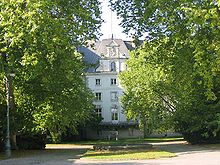Albert Geyer
Albert Geyer (born May 17, 1846 in Charlottenburg , † September 14, 1938 in Berlin ) was a German architect and Prussian construction clerk who also worked as a building historian .
Life
Albert Geyer, born on May 17, 1846 in Charlottenburg, which at that time did not belong to Berlin, was the son of the teacher and preacher Ludwig Geyer , the brother of the sculptor Otto Geyer , the teacher at the Friedrichwerder Gymnasium Paul Geyer and the theologian Ernst Theodor Geyer. At the age of 19 he graduated from the Friedrich-Werderschen Gymnasium . A scholarship enabled him to study philosophy and mathematics at Berlin University from 1867 to 1869 , although he would have preferred to study architecture. His military service as a one-year volunteer in 1866 coincided with the Austro-Prussian War .
In addition to his studies, he worked as an intern with Wilhelm Haeger in the construction office for the new building of the Reichsbank, in order to later be able to study at the Berlin Building Academy . After participating in the Franco-Prussian War in 1870/71, he began studying at the building academy, which he temporarily completed in 1874 with the master builder examination. His excellent result was honored with a government travel award, which he used for a study trip to Switzerland , Belgium , France and Germany . He was then employed by Reinhold Persius for his private buildings in Potsdam .
At the building academy he passed the master builder examination in 1880 and became a member of the palace building commission. From 1909 until its dissolution on April 1, 1921, he was its last director. Under his leadership - often based on designs by the imperial court architect Ernst von Ihne - extensive renovations and modernizations were carried out, for example at the Berlin City Palace.
In 1909 he was made an extraordinary member and in 1913 a full member of the Prussian Academy of Civil Engineering .
With the end of the monarchy and the dissolution of the palace building commission, a new phase began for him. He retired and began his long career as an architectural historian, including his monograph on the history of the Berlin Palace. From 1922 to 1929 he was President of the Prussian Academy of Building for three terms.
He died at the age of 92 on September 14, 1938 in Berlin and was buried in the Dorotheenstädtisch-Friedrichswerder cemetery .
plant
Buildings and designs
- 1887/1888: Reconstruction of Kiel Castle (destroyed in World War II)
- 1888/1889: Extension of the mausoleum in the park of Charlottenburg Palace in Berlin, for Kaiser Wilhelm I († 1888) and Empress Augusta († 1890)
- 1889: Reconstruction of the Glienicke hunting lodge for Prince Friedrich Leopold of Prussia
- 1891–1905: various conversions of the Berlin City Palace (partly based on a design by Ernst von Ihne ; destroyed)
- 1899–1900: Design for the reconstruction and extension of Sigmaringen Castle by the Princes of Hohenzollern
- 1905–1909: Reconstruction of Neustrelitz Castle in Neustrelitz (destroyed)
- 1907: Draft for the reconstruction of Babelsberg Palace in Potsdam (not executed)
- 1910–1913: Jubilee terraces at the New Orangery in Potsdam
Fonts
Albert Geyer wrote numerous publications on Berlin palaces, a. a.
- The historic living rooms in the Berlin Palace . German art publisher, Berlin 1926.
- History of the palace in Berlin. Volume 1, The Electoral Period up to 1698 . 1936 / as reprint : Nicolai, Berlin 1993, ISBN 3-87584-480-7 .
- History of the palace in Berlin. Volume 2, From the royal palace to the palace of the emperor (1698–1918) . 1936. / as reprint: Nicolai, Berlin 1993, ISBN 3-87584-431-9 .
Web links
- Literature by and about Albert Geyer in the catalog of the German National Library
Individual evidence
- ↑ Franz-Severin Gäßler: Albert Geyer and the expansion of the residential palace of the Hohenzollern in Sigmaringen 1893-1908. In: Hohenzollerische Heimat. 56, 2, 2006, pp. 17-21.
| personal data | |
|---|---|
| SURNAME | Geyer, Albert |
| BRIEF DESCRIPTION | German architect and Prussian building officer |
| DATE OF BIRTH | May 17, 1846 |
| PLACE OF BIRTH | Charlottenburg |
| DATE OF DEATH | September 14, 1938 |
| Place of death | Berlin |

